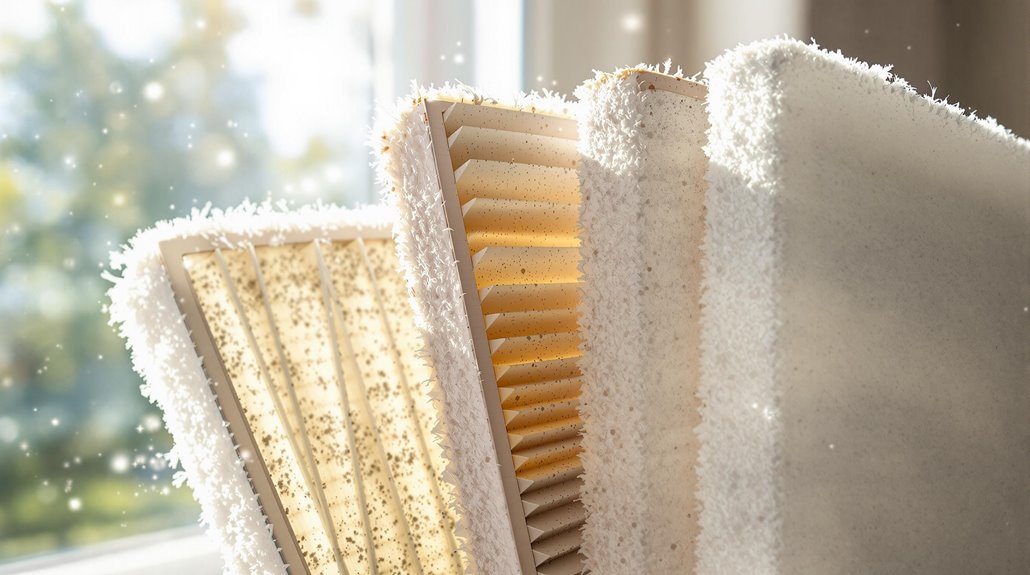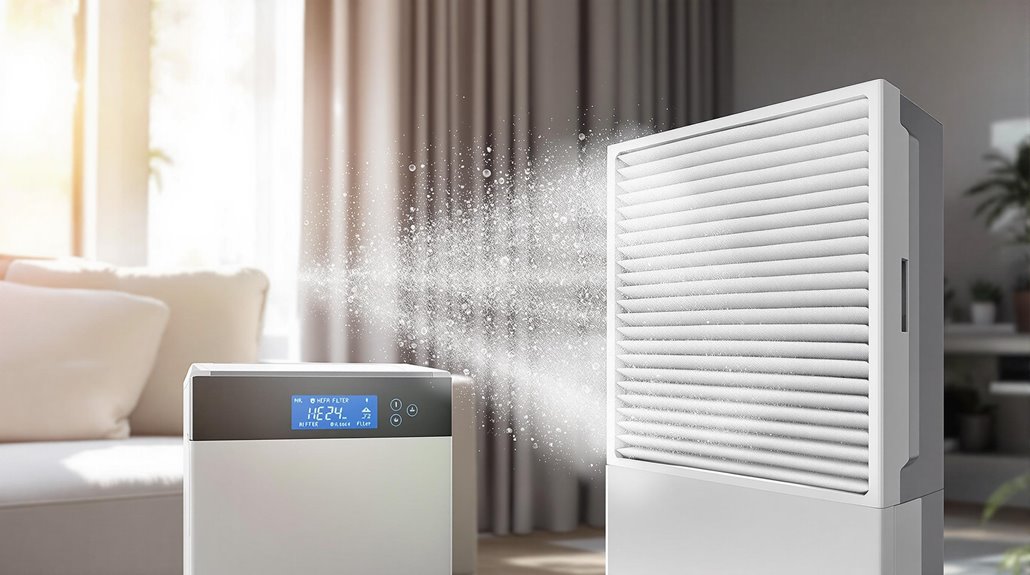You’re being misled about home air filters’ true capabilities. While manufacturers tout impressively high MERV ratings (1-20 scale), these numbers don’t tell the whole story. Standard filters only capture larger particles, leaving dangerous VOCs, bacteria, and microscopic pollutants untouched. Your indoor air can be 2-5 times more polluted than outdoor air, and basic filtration won’t solve it. Proper installation, regular maintenance, and understanding filter limitations reveal the critical steps for actually protecting your home’s air quality.
Understanding Different Types of Air Filters

While many homeowners assume all air filters are created equal, the stark differences between filter types can mean the difference between clean air and a false sense of security.
You’ll find a hierarchy of filter materials, from basic fiberglass that barely traps large particles to high-efficiency HEPA filters that capture microscopic contaminants.
The market’s flooded with deceptive claims about filter types, but here’s what you need to know: Pleated filters outperform flat ones, and electrostatically charged materials catch more particles than standard options.
You’re likely paying premium prices for mediocre protection if you haven’t researched your filter’s MERV rating – the industry standard for filtration effectiveness.
Don’t fall for marketing gimmicks; understanding filter materials and their true capabilities will help you make informed decisions about your home’s air quality.
Common Air Quality Pollutants in Your Home
Your home’s air contains microscopic threats you can’t see but definitely should know about, including volatile organic compounds released from everyday products like cleaners, paints, and pressed wood furniture.
Pet dander and dust accumulate relentlessly in corners, on surfaces, and in your ventilation system, triggering allergies and respiratory issues that affect your family’s health and productivity.
While you’re going about your daily routine, mold and bacteria thrive in damp areas of your home, releasing spores and toxins that can lead to serious health complications, especially in children and elderly residents.
Volatile Organic Compounds (VOCs)
Hidden toxins lurk throughout modern homes in the form of volatile organic compounds (VOCs), dangerous chemicals that readily evaporate at room temperature.
These pervasive pollutants emanate from everyday items you’d never suspect, compromising your indoor air quality and potentially your health.
Common VOCs sources in your home include:
- Fresh paint, varnishes, and wood stains that off-gas for months
- New furniture and carpeting made with formaldehyde-based adhesives
- Air fresheners and cleaning products containing artificial fragrances
- Dry-cleaned clothing and pressed wood products
Your exposure to VOCs can trigger immediate symptoms like headaches, dizziness, and respiratory irritation.
Long-term VOCs health impacts may include liver damage, nervous system disorders, and increased cancer risk.
Most concerning, indoor VOC levels typically measure 2-5 times higher than outdoor concentrations.
Pet Dander and Dust
Despite regular cleaning efforts, microscopic particles of pet dander and dust accumulate relentlessly in your home’s air. These invisible invaders measure as small as 0.3 microns – so tiny that thousands could fit on a pinhead. For the 15-30% of Americans suffering from pet allergies, these particles trigger significant respiratory distress.
You’ll find dust mites thriving in every corner of your living space, feeding on the dead skin cells that both you and your pets shed daily. A single mattress can harbor up to 10 million of these microscopic creatures.
While you might think your weekly vacuuming routine addresses the problem, standard cleaning captures only 5% of airborne dander and dust. The remaining 95% continues circulating through your home’s air system, settling on surfaces and re-entering the air you breathe.
Mold and Bacteria Growth
While homeowners focus on visible cleanliness, dangerous microorganisms multiply in the dark, damp spaces of their homes. Your HVAC system’s moist environment creates perfect conditions for mold and bacteria colonies to thrive, potentially triggering severe respiratory issues and compromising your family’s health.
Consider these critical growth zones in your home:
- Air ducts with condensation buildup
- Bathroom ventilation systems lacking proper mold prevention
- Basement areas with poor bacteria control measures
- Window sills and frames with moisture accumulation
You’re likely breathing in these microscopic invaders right now. Studies show that indoor air contains up to 500% more airborne contaminants than outdoor air, yet most households lack adequate filtration systems.
Without proper maintenance and air purification, you’re fundamentally creating an incubator for harmful microorganisms in your living space.
The Science Behind Air Filter Ratings
You’ll find it shocking that the $40 filter you just bought might only be trapping 20% of harmful particles, based on its Minimum Efficiency Reporting Value (MERV) rating.
MERV ratings, established by the American Society of Heating, Refrigerating and Air-Conditioning Engineers, measure a filter’s ability to capture particles between 0.3 and 10 microns in size through standardized testing procedures.
Your home’s air quality directly depends on choosing the right MERV rating, with higher numbers indicating better filtration – though the industry’s marketing often obscures this vital detail behind flashy packaging and vague promises.
MERV Ratings Explained
The MERV rating system stands as the industry’s definitive benchmark for measuring an air filter’s ability to capture airborne particles.
You’ll find ratings from 1-20, with higher numbers indicating superior filtration performance. Understanding these ratings is essential for maintaining your home’s air quality and optimizing filter lifespan.
- MERV 1-4: Basic filtration that catches large particles like dust and carpet fibers
- MERV 5-8: Mid-range filters that trap pet dander and mold spores
- MERV 9-12: Advanced filtration capturing lead dust and auto emissions
- MERV 13-20: Hospital-grade filters blocking bacteria and smoke particles
Don’t automatically assume you need the highest MERV rating.
Your HVAC system has specific requirements, and using a filter with too high a rating can restrict airflow, forcing your system to work harder and potentially causing damage.
Filter Standards and Testing
Despite rigorous industry standards, many air filter manufacturers employ varying test methods to achieve their published ratings. Testing protocols differ between labs, creating inconsistent results that can mislead consumers.
While the ASHRAE 52.2 standard exists to measure filter efficiency, you’ll find companies using modified versions of this test to highlight their products’ best performance.
Independent laboratories expose this troubling pattern. They’ve discovered that up to 30% of filters don’t meet their advertised ratings when tested under standardized conditions.
Major manufacturers often test their filters using specialized particulates that aren’t representative of real-world contaminants. You’re paying premium prices for filters tested under ideal conditions that rarely match your home’s environment.
The solution? Look for filters verified by third-party testing organizations using ASHRAE’s unmodified testing methods, ensuring you get the performance you’re promised.
Proper Installation and Maintenance Guidelines
While proper installation may seem straightforward, failing to follow manufacturers’ guidelines can sabotage your air filter’s effectiveness from day one.
Your filter installation process directly impacts your home’s air quality, energy bills, and HVAC system longevity. You’ll need to master these essential maintenance tips to protect your investment.
- Check the airflow arrow on your filter’s frame – installing it backwards reduces efficiency by up to 50%
- Measure your filter slot precisely – even a 1/4 inch gap allows unfiltered air to bypass the system
- Replace filters every 60-90 days, or monthly if you have pets
- Document installation dates with a marker on the filter frame, and set digital reminders
Don’t let poor maintenance compromise your indoor air quality.
Your attention to these details will maximize filtration and extend your HVAC system’s life.
Health Benefits and Limitations of Air Filtration

Modern air filtration systems provide remarkable health benefits for indoor spaces, yet many homeowners don’t realize their limitations. These systems can remove up to 99.97% of airborne particles, including dust, pollen, and pet dander, greatly reducing allergy symptoms and respiratory issues.
You’ll notice improved sleep quality and decreased instances of morning congestion.
However, filtration limitations are often overlooked by manufacturers’ marketing claims. Even the most advanced HEPA filters can’t eliminate all indoor air pollutants. They’re ineffective against gases, volatile organic compounds (VOCs), and some viruses.
Your filter won’t address structural issues like poor ventilation or moisture problems. Studies show that while air filters reduce particulate matter, they must be part of a thorough indoor air quality strategy to truly protect your health.
Choosing the Right Filter for Your Space
Understanding your space’s unique filtration needs can mean the difference between wasting money and achieving genuinely clean air. Your filter efficiency rating should align with your specific indoor air challenges, while considering filter lifespan to manage ongoing costs.
- Measure your space’s square footage and ceiling height to determine the minimum CADR (Clean Air Delivery Rate) needed.
- Consider your home’s specific pollutants – pet dander requires different filtration than cooking fumes.
- Factor in your HVAC system’s compatibility with higher MERV ratings to avoid strain.
- Calculate long-term costs by multiplying filter replacement intervals by annual usage.
Don’t fall for marketing claims about “universal” solutions. A filter that’s perfect for a small apartment won’t necessarily perform in a sprawling ranch house, regardless of its premium price tag.
Conclusion
You’ve learned that effective air filtration isn’t just about buying the most expensive filter – it’s about making informed choices for your specific needs. Consider this: the EPA reports that indoor air can be 2-5 times more polluted than outdoor air, yet 87% of homeowners don’t change their filters on schedule. By selecting the right filter and maintaining it properly, you’ll breathe easier knowing you’re protecting your family’s health and your HVAC system’s longevity.





